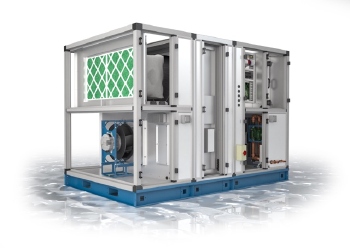Taking effective control of ventilation

Are some approaches to demand-controlled ventilation so complex that they are not effective in reducing overall cost and carbon footprint. Andrew Bott of Nuaire shares his views.
The arguments for saving energy through high-efficiency ventilation are clear, and for decades the industry has been aware of the benefits of ‘demand control’, But do we really use it wisely, and do we really consider the overall cost?
In discussing ventilation on demand, let us consider an office which houses 100 staff who will all start work at 9 a.m. In this scenario the primary heating system will usually begin work at around 7 a.m., raising the room temperature for the start of the day and with the ventilation system off or in trickle mode.
Consider now the implications of two or three managers arriving early to work. In this situation a PIR-controlled ventilation system would start immediately and deliver the full design amount of fresh air, despite the fact there are only one or two members of staff in the office.
Aside from the obvious waste of fan energy, there are other energy leaks we should consider.
The room load calculations are probably based on 100 people generating heat, computers that are not currently running, and the simple fact that even the most efficient heat-recovery system takes time to reach a comfortable operating temperature.
 |
| Contributing to the energy efficiency of this packaged air-handling unit is L1 leakage class, TB1 thermal bridging, D1 deflection class and T2 thermal transmittance, It also has a BACnet controller. |
The simple introduction of CO2 sensor control to directly link the ventilation rate to occupancy yields a number of key benefits by lowering the energy consumption of the fans to meet the occupancy demand, but the other energy drains are reduced too.
With the CO2 sensor in place, as the occupancy levels rise so does the ventilation system fan speed, extracting the stale air and delivering conditioned fresh air. This process quickly begins to lower the CO2 levels and drives the ventilation rate towards its default minimum. So I often pose the question will this system ever run at the full design duty?
There is one other consideration for demand ventilation which is often overlooked, and that is the relationship between cost and the overall carbon impact.
There are so many occasions where expensive or complex systems are implemented in the name of ‘energy reduction’ without any consideration for the balance between the cost and the potential savings.
Let us briefly ignore the financial implications of a demand-controlled solution and consider only the carbon footprint of the systems we design. It is often the case that the overall carbon impact of producing, shipping and installing an over-engineered demand-controlled solution far outweighs the potential savings it is designed to deliver.
Over the years I have seen so many solutions involving dampers, complex controls, extensive ductwork and countless hours of design resources committed to saving just a very small amount of energy a day, amounting to a few kilograms of carbon over the whole project lifecycle.
Considering the capital costs and more importantly the potential return on investment, the same contradiction occurs. Sometimes many thousands of pounds are spent designing and implementing a system that will yield only a few hundred pounds worth of energy savings over its entire life span.
 |
| Control options, left to right — PIR device to enable fan on detection of occupancy; temperature sensor to control fan speed according to temperature in the conditioned space; wall-mounted combined CO2 and temperature sensor that can control the fan speed according to either parameter, on a highest-takes-precedence basis. |
Does this mean that we should give up on demand control as an expensive waste of resources in an ever-diminishing attempt to reduce our energy consumption? The answer to this question is, of course, no. We should use demand-controlled ventilation where and whenever its savings outweigh its costs, either in financial or carbon terms. Finding a balance with the systems we design, by considering initial cost, life-cycle savings and by aiming for a sensible return on investment whilst delivering a respectable carbon reduction is the only way to truly implement demand controlled ventilation.
The simple addition of a CO2 speed controller to a classroom, or a humidity sensor to a changing room, can transform the energy consumption of the conditioned space in next to no time. The capital cost of such devices is low, and the return on investment is swift. The carbon footprint for delivering the solution is minimal, and the carbon saving, once implemented, is significant. These systems are designed to work straight out of the box and require little or no setup, beyond choosing a set-point.
So my challenge to the industry is a simple one. Where it is appropriate and when it yields the greatest benefit to the built environment, use these solutions wherever possible. But avoid designing complex solutions that cost far more than they ever could save.
Remember there is still a place in the world for the humble PIR sensor, and often this is all that is needed to achieve significant savings. When you are designing complex spaces with large swings in occupancy or unusual usage characteristics, consider the key metric to identify demand and use this to drive control, keeping systems simple, proportional and cost effective.
Andrew Bott is technical engineer with Nuaire.








